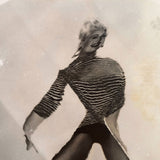





















Arthur Felling, better known as Weegee (1899-1968) was a highly-successful (and notorious) photojournalist/artist. In addition to contributing an enormous number of images to various American newspapers, he would become famous, beyond New York and news circles, after the publication of Naked City (1945) and Weegee's People (1946).
Weegee's images of New York City crime, mishaps and tragedy are iconic and influential. Less well-known, however, is the work he focused on during the last twenty years of his life: known as the 'distortions' period. In the late 1940s, Weegee began experimenting with photographic manipulation both in the darkroom and using an array of filters or prisms (kaleidoscope) that created caricatured and distorted images.
Weegee created distortions of a wide range of subjects; celebrities, architecture, circus life, and nudes. "Jayne Mansfield Distortion" is a superb example of one of Weegee's images from this era.
Weegee's satirical images of celebrity pre-date Warhol's silkscreens by almost a decade. Similarly, many of the themes Weegee was exploring in these distortions, such as the cult of the artist, the cost of fame and the power/ubiquity of film stars, were expanded upon by Warhol in the 1960's. The artists knew each other and Weegee actually photographed Warhol on several occasions both straight on and as a distortion.
Weegee’s photography can be found in scores of museums and private collections worldwide: the J. Paul Getty Museum, Los Angeles; Museum of Modern Art, New York; San Francisco Museum of Modern Art; Museum of Modern Art, Oxford; Museum of Contemporary Art, Los Angeles; International Center of Photography, New York and more.
Questions about this piece? Contact us or call +1.416.704.1720
USA, circa 1960
Gelatin silver print
8.5"H 6.5"W (work)
15.75"H 12.5"W (framed)
"Weegee From Photo Representative" stamp (verso).
Condition: age toning and light stain right edge
- Where does the inventory ship from?
Our inventory is divided between New York and Toronto.
- Where do you ship to?
We can ship anywhere. Typically when we ship within North America we prefer to use FedEx or DHL. To Europe, Asia and beyond we generally use DHL.
- How much does it cost to ship?
For shipments within North America, we typically charge a flat rate fee. Many items on our site will list the rate. For shipping outside of North America, we can easily provide a quote and will look for the most efficient and economical option.
Most of the items on our site can be easily shipped internationally.
Occasionally we will recommend that an artwork be removed from its frame for shipping. Larger framed works are typically framed with plexiglass. We export over 80% of what we sell, so we are comfortable shipping anywhere.
- Are there additional taxes or fees?
When a work is valued above $2,500 usd there is a possibility of tax of 0.35%, but this is applied sporadically. There can similarly be an additional fee for customs brokerage and this can range from $20 - $65. US Taxes, duties and customs brokerage are not included in our flat rate shipping. However most of our shipments to the US enter without any additional fees.
- Do you provide a certificate of authenticity?
Yes, we guarantee everything we sell. We can provide both a digital and printed version of our certificate of authenticity.
What is your return policy?
- Caviar20 wants you to be 100% satisfied with your purchase. We have a 7 day no-questions full refund return policy for your purchase. Shipping charges are non-refundable. Return shipping is the responsibility of the customer. After 8 days returns are given a credit note. There is no expiration for our credit notes.
- What payment methods do you accept?
Canadian clients are welcomed and encouraged to pay with interac.
